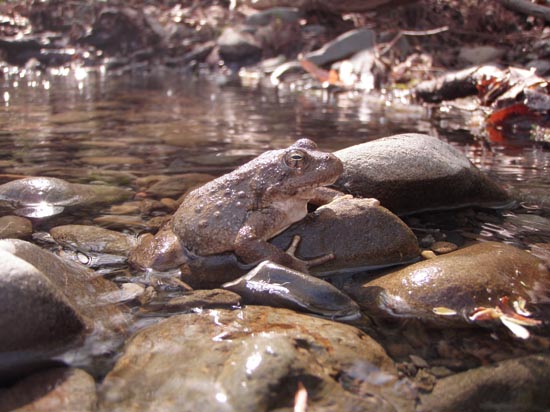In 2015, SAVE THE FROGS! received a grant from the Alameda County Fish & Game Commission to research disease outbreaks in Foothill Yellow-Legged Frogs (Rana boylii) in the San Francisco Bay Area. The research was published in the journal Ecosphere. You can read the abstract below, or download the PDF of the publication here.

Photo of gravid female Rana boylii from Alameda Creek by Dr. Sarah Kupferberg
Extreme drought, host density, sex, and bullfrogs influence fungal pathogen infection in a declining lotic amphibian.
Andrea J. Adams, Sarah J. Kupferberg, Mark Q. Wilber, Allan P. Pessier, Marcia Grefsrud , Steve Bobzien, Vance T. Vredenburg and Cheryl J. Briggs
Ecosphere. March 2017. Volume 8(3). Article e01740
Freshwater biodiversity is imperiled across the globe, and multiple stressors such as habitat alteration, non-native species invasion, disease, and climate change can act in concert to threaten vulnerable taxa. The amphibian chytrid fungus Batrachochytrium dendrobatidis (Bd), which causes the disease chytridiomycosis, is one of the causative factors of severe amphibian declines. The foothill yellow-legged frog (Rana boylii) is a stream-breeding anuran endemic to California and Oregon (USA) that has declined precipitously in recent decades, yet there is little information on its susceptibility to Bd. In the fall of 2013, we observed dead and dying juvenile R. boylii in a San Francisco Bay Area watershed where annual amphibian breeding censuses have been conducted since 1997 in a free-flowing reach and since 2003 in an anthropogenically modified stream reach. High pathogen loads on R. boylii and histologic lesions observed on a dead R. boylii metamorph collected from the site were consistent with lethal chytridiomycosis. The outbreak coincided with extremely low stream flows in autumn that concentrated frogs in drying pools and the absence of high peak flows in winter that allowed non-native American bullfrogs (Rana catesbeiana) to expand their spatial distribution in the stream network. Following the outbreak, we surveyed R. boylii and sympatric anurans at the site for the next two years to determine Bd trends within the population. Using mixed-effects models, we found that bullfrog presence was a positive predictor of both Bd prevalence and Bd load in R. boylii. Prevalence was also influenced by sex and life stage: Adult males were more likely to be infected than either females or juveniles. Moreover, we found that stream flow volume was negatively associated with Bd load. These results indicate that disease, drought, and flow regulation may interact synergistically to impact amphibians in ways not previously recognized, informing stream flow management strategies for native aquatic taxa.

